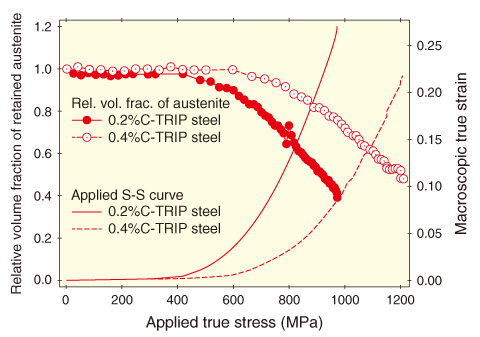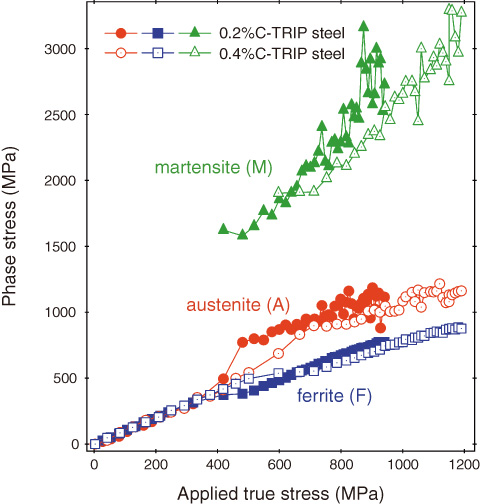
Fig.13-4 Illustration of TRIP effect

Fig.13-5 Changes in relative volume fraction of retained austenite and stress-strain curve of TRIP steels

Fig.13-6 Stress partitioning among constituent phases of TRIP steel during deformation
Transformation-induced plasticity (TRIP) is an important effect in steel that improves the strength and ductility and realizes excellent high-speed deformation behavior. Steels with 0.2%C-TRIP and 0.4%C-TRIP are known to have excellent shock absorption in collisions and are expected to be used in car bodies. The TRIP effect, as shown in Fig.13-4, occurs in steel having a metastable phase (the A phase) that can transform into a stronger phase (the M phase) during plastic deformation. However, there is almost no quantitative research on the behavior causing the TRIP effect that directly shows the contribution of the M phase to the strength. We attempt to understand this behavior using neutron diffraction.
We performed in-situ neutron diffraction experiments during tensile loading at room temperature using the Engineering Materials Diffractometer TAKUMI at the Materials and Life Science Experimental Facility of J-PARC. TAKUMI can perform an in-situ neutron diffraction experiment during deformation without interruption of the load or displacement because of its high intensity and instantaneous data collection system. The relative volume fractions of the A phase obtained from neutron diffraction, as shown in Fig.13-5, are gradually decreased with increasing applied stress after the onset of plastic deformation, showing that a deformation-induced martensitic transformation occurs. Fig.13-6 shows the phase stresses that are shared by the constituent phases in the TRIP steels during tensile deformation. The M phase stresses are found to be the highest and the ferrite phase stresses are the lowest among the constituent phases. Moreover, the bulk stresses that are estimated using these phase stresses and the volume fractions show good agreement with the applied stresses.